



Avoiding discomfort after enjoying a glass of fermented grape beverage is crucial for many enthusiasts. The presence of sulfites, tannins, and histamines in these drinks can lead to digestive issues for some individuals. If you find yourself experiencing an uncomfortable sensation in your abdomen after indulging, it might be wise to monitor your intake closely.
Research indicates that certain compounds within these beverages can trigger bloating. For instance, the sugar content can contribute to fermentation in the gut, resulting in gas production. Choosing options with lower sugar levels or opting for organic varieties may mitigate these effects. Additionally, serving temperature can influence how your body reacts; cooler beverages tend to be more refreshing and easier on the stomach.
Pairing these drinks with food can also alleviate digestive distress. Consuming fiber-rich meals before or during drinking can slow down absorption, leading to a more pleasant experience. Staying hydrated is equally important; drinking water alongside your chosen beverage can help reduce potential bloating and promote better digestion.
Effects of Red Varietals on Digestive Comfort
Opting for a glass of dark varietal can lead to feelings of fullness and discomfort for some individuals. Several factors contribute to this sensation.
- Alcohol Content: Higher levels in these beverages can irritate the stomach lining, potentially causing gas and discomfort.
- Sulfites: Common preservatives in many bottles may provoke reactions in sensitive individuals, contributing to bloating.
- Histamines: Found in significant quantities, these compounds can trigger allergic responses, leading to swelling and gastrointestinal distress.
- Acidity: The natural acidity present can result in acid reflux or heartburn, which might be mistaken for bloating.
To mitigate these effects, consider the following strategies:
- Choose lower-alcohol options to minimize irritation.
- Look for wines with reduced sulfite levels.
- Select varietals with lower histamine concentrations, such as certain whites or rosés.
- Pace yourself, allowing your body time to process each glass.
Pay attention to how your body reacts and adjust your choices accordingly for a more enjoyable experience. Personal awareness is key in identifying what works best for individual comfort levels.
Understanding the Ingredients in Red Wine

Fermented grape juice is the foundation of this beverage, with various components influencing its characteristics. The primary ingredient, grapes, contribute sugars, acids, and tannins, which play significant roles in flavor and texture. Different grape varieties yield distinct profiles, impacting the drinking experience.
Alcohol content, generally ranging from 12% to 15%, results from the fermentation process where yeast converts sugars into alcohol. Higher alcohol levels can lead to a heavier sensation on the palate, which some may find uncomfortable.
Acidity, derived from organic acids such as tartaric and malic acid, affects the overall balance and freshness of the drink. A higher acidity can enhance crispness, yet excessive levels might induce discomfort for some individuals.
Tannins, naturally occurring compounds found in grape skins, seeds, and stems, contribute to astringency and structure. They also interact with proteins in the body, potentially leading to sensations of fullness or discomfort for sensitive drinkers.
Other compounds, such as sulfites, are added as preservatives to maintain stability. While generally regarded as safe, some individuals may experience sensitivities, resulting in various physical reactions.
Understanding these elements can guide choices, ensuring a more enjoyable experience while minimizing any potential discomfort associated with consumption. Selecting components that align with personal preferences is key to enhancing enjoyment and mitigating adverse effects.
How Alcohol Affects Digestion and Bloating
Excessive consumption of alcoholic beverages can lead to various digestive issues. Ethanol, the primary component in these drinks, interferes with the natural function of the digestive system. This disruption can result in inflammation of the stomach lining, causing discomfort and distension.
Alcohol has a dehydrating effect, which can alter gut motility. This alteration may slow down the digestive process, leading to a backlog of food and gas production. The fermentation of undigested food can contribute to a feeling of fullness and pressure in the abdomen.
Impact on Gut Flora
Regular intake of alcoholic beverages can negatively affect the balance of gut microbiota. A healthy gut flora is essential for proper digestion and nutrient absorption. Disruption of this balance can lead to an increase in harmful bacteria, exacerbating bloating and discomfort.
Recommendations for Minimizing Discomfort
To alleviate potential issues, moderation is key. Opting for smaller quantities and choosing beverages with lower alcohol content can be beneficial. Staying hydrated with water alongside alcohol can help mitigate dehydration effects. Additionally, incorporating probiotics and fiber-rich foods into your diet promotes a healthier digestive environment, reducing the likelihood of experiencing discomfort after consuming alcoholic drinks.
The Role of Sulfites and Histamines in Red Wine
Individuals sensitive to sulfites may experience discomfort after consuming certain varieties of fermented grapes. Sulfites, commonly added as preservatives, can provoke reactions, including digestive issues. Therefore, checking for low-sulfite options can mitigate such adverse effects.
Histamines, which occur naturally in fermented products, can also contribute to discomfort. For those with histamine intolerance, symptoms may manifest through headaches or digestive distress. Selecting wines with lower histamine levels can help alleviate these reactions.
| Component | Source | Possible Effects |
|---|---|---|
| Sulfites | Preservative added to wine | Digestive discomfort, allergic reactions |
| Histamines | Naturally occurring in fermented products | Headaches, digestive issues |
Exploring options like organic or biodynamic selections may yield wines with fewer additives, potentially reducing negative experiences. Always read labels carefully and consider consulting with a wine specialist for tailored recommendations.
For those interested in practical applications, understanding how other systems work can also be beneficial. For example, how do the detergent tanks work on a pressure washer can provide insights into effective usage and maintenance, drawing parallels to the importance of understanding ingredients in beverages.
Identifying Personal Sensitivities to Red Wine

Recognizing individual reactions to fermented beverages is crucial. Start by maintaining a detailed log of your consumption, noting the specific types and amounts of each beverage consumed, along with any physical responses experienced afterward. This will help identify patterns related to discomfort or digestive issues.
Consider the timing of your intake. Drinking on an empty stomach can amplify adverse effects. Experiment with pairing these beverages alongside food to observe if this mitigates any discomfort. Choose lighter meals, as heavy or rich foods can exacerbate bloating sensations.
Assessing Ingredients
Pay attention to the specific varietals and regions. Certain grapes might trigger different reactions due to their chemical compositions. For example, tannins can provoke sensitivities in some individuals, leading to gastrointestinal distress. If you suspect a particular variety, try alternatives from different regions or production methods.
Consultation and Testing
If discomfort persists, engage with a healthcare professional. They may suggest testing for intolerances or allergies to specific compounds commonly found in fermented products. This can provide clarity on whether sulfites, histamines, or other components are culprits behind your reactions.
Tips to Enjoy Red Wine Without Bloating
Opt for smaller servings. Keeping portions moderate helps minimize discomfort. A standard pour of five ounces is usually sufficient.
Stay hydrated. Drinking water alongside your beverage can aid digestion and reduce the likelihood of feeling puffy afterward.
Choose lower-alcohol varieties. Wines with a lower alcohol content can be easier on the stomach and less likely to cause distension.
Be mindful of food pairings. Enjoying a meal with your drink can help buffer the effects, especially with fiber-rich foods that support digestion.
Consider aeration. Allowing the liquid to breathe for at least 30 minutes before consumption can mellow flavors and reduce potential irritants.
Experiment with temperature. Serving at an optimal temperature can enhance flavor and may lead to a more pleasant experience overall.
Keep track of your body’s signals. Noting how different types affect you can guide future choices and enhance enjoyment.
Seek out organic selections. These options often have fewer additives, which may contribute to a more comfortable experience.
Limit consumption of carbonated beverages. Mixing sparkling drinks can increase gas buildup, leading to discomfort.
Enjoy slowly. Sipping at a leisurely pace allows your body to process the beverage more effectively, reducing the risk of fullness.









